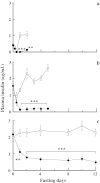Age-related effects of fasting on ketone body production during lipolysis in rats
- PMID: 21850422
- PMCID: PMC3342632
- DOI: 10.1007/s12199-011-0231-0
Age-related effects of fasting on ketone body production during lipolysis in rats
Abstract
Objective: The age-related effects of fasting on lipolysis, the production of ketone bodies, and plasma insulin levels were studied in male 3-, 8-, and 32-week-old Sprague-Dawley rats.
Methods: The rats were divided into fasting and control groups. The 3-, 8- and 32-week-old rats tolerated fasting for 2, 5, and 12 days, respectively.
Results: Fasting markedly reduced the weights of perirenal and periepididymal white adipose tissues in rats in the three age groups. The mean rates of reduction in both these adipose tissue weights during fasting periods were higher in the order of 3 > 8 > 32-week-old rats. Fasting transiently increased plasma free fatty acid (FFA), total ketone body, β-hydroxybutyrate, and acetoacetate concentrations in the rats in the three age groups. However, plasma FFA, total ketone body, β-hydroxybutyrate, and acetoacetate concentrations in the 3-week-old rats reached maximal peak within 2 days after the onset of fasting, although these concentrations in the 8- and 32-week-old rats took more than 2 days to reach the maximal peak. By contrast, the augmentation of plasma FFA, total ketone body, β-hydroxybutyrate, and acetoacetate concentrations in the rats in the three age groups had declined at the end of each experimental period. Thus, the capacity for fat mobilization was associated with tolerance to fasting. Plasma insulin concentrations in the rats in the three age groups were dramatically reduced during fasting periods, although basal levels of insulin were higher in the order of 32 > 8 > 3 week-old rats.
Conclusion: These results suggest that differences in fat metabolism patterns among rats in the three age groups during prolonged fasting were partly reflected the metabolic turnover rates, plasma insulin levels, and amounts of fat storage.
Figures






Similar articles
-
Effect of insulin and acute diabetes on plasma FFA and ketone bodies in the fasting rat.J Clin Invest. 1970 Sep;49(9):1685-93. doi: 10.1172/JCI106386. J Clin Invest. 1970. PMID: 5452413 Free PMC article.
-
Rapid intravenous sodium acetoacetate infusion in man. Metabolic and kinetic responses.J Clin Invest. 1973 Oct;52(10):2606-16. doi: 10.1172/JCI107453. J Clin Invest. 1973. PMID: 4729054 Free PMC article.
-
Effects of oleic acid infusion on plasma free fatty acids and blood ketone bodies in the fasting rat.Metabolism. 1976 Apr;25(4):361-73. doi: 10.1016/0026-0495(76)90068-8. Metabolism. 1976. PMID: 1263831
-
Human ketone body production and utilization studied using tracer techniques: regulation by free fatty acids, insulin, catecholamines, and thyroid hormones.Diabetes Metab Rev. 1989 May;5(3):285-98. doi: 10.1002/dmr.5610050306. Diabetes Metab Rev. 1989. PMID: 2656157 Review.
-
Update on Measuring Ketones.J Diabetes Sci Technol. 2024 May;18(3):714-726. doi: 10.1177/19322968231152236. Epub 2023 Feb 16. J Diabetes Sci Technol. 2024. PMID: 36794812 Free PMC article. Review.
Cited by
-
Higher beta-hydroxybutyrate ketone levels associated with a slower kidney function decline in ADPKD.Nephrol Dial Transplant. 2024 Apr 26;39(5):838-847. doi: 10.1093/ndt/gfad239. Nephrol Dial Transplant. 2024. PMID: 37974030 Free PMC article.
-
Environmental Enrichment and Estrogen Upregulate Beta-Hydroxybutyrate Underlying Functional Improvement.Front Mol Neurosci. 2022 May 3;15:869799. doi: 10.3389/fnmol.2022.869799. eCollection 2022. Front Mol Neurosci. 2022. PMID: 35592114 Free PMC article.
-
Five Days Periodic Fasting Elevates Levels of Longevity Related Christensenella and Sirtuin Expression in Humans.Int J Mol Sci. 2021 Feb 26;22(5):2331. doi: 10.3390/ijms22052331. Int J Mol Sci. 2021. PMID: 33652686 Free PMC article. Clinical Trial.
-
Folate-deficiency induced cell-specific changes in the distribution of lymphocytes and granulocytes in rats.Environ Health Prev Med. 2013 Jan;18(1):78-84. doi: 10.1007/s12199-012-0286-6. Epub 2012 May 27. Environ Health Prev Med. 2013. PMID: 22644659 Free PMC article.
-
A Potential Role for the Ketogenic Diet in Alzheimer's Disease Treatment: Exploring Pre-Clinical and Clinical Evidence.Metabolites. 2023 Dec 29;14(1):25. doi: 10.3390/metabo14010025. Metabolites. 2023. PMID: 38248828 Free PMC article. Review.
References
-
- Williamson DH, Whitelaw E. Physiological aspects of the regulation of ketogenesis. Biochem Soc Symp. 1978;43:137–161. - PubMed
-
- Beylot M. Regulation of in vivo ketogenesis: role of free fatty acids and control by epinephrine, thyroid hormones, insulin and glucagons. Diabetes Metab. 1996;22:299–304. - PubMed
-
- Kalderon B, Mayorek N, Berry E, Zevit N, Bar-Tana J. Fatty acid cycling in the fasting rat. Am J Physiol Endocrinol Metab. 2000;279:E221–E227. - PubMed
Publication types
MeSH terms
Substances
LinkOut - more resources
Full Text Sources
Medical
